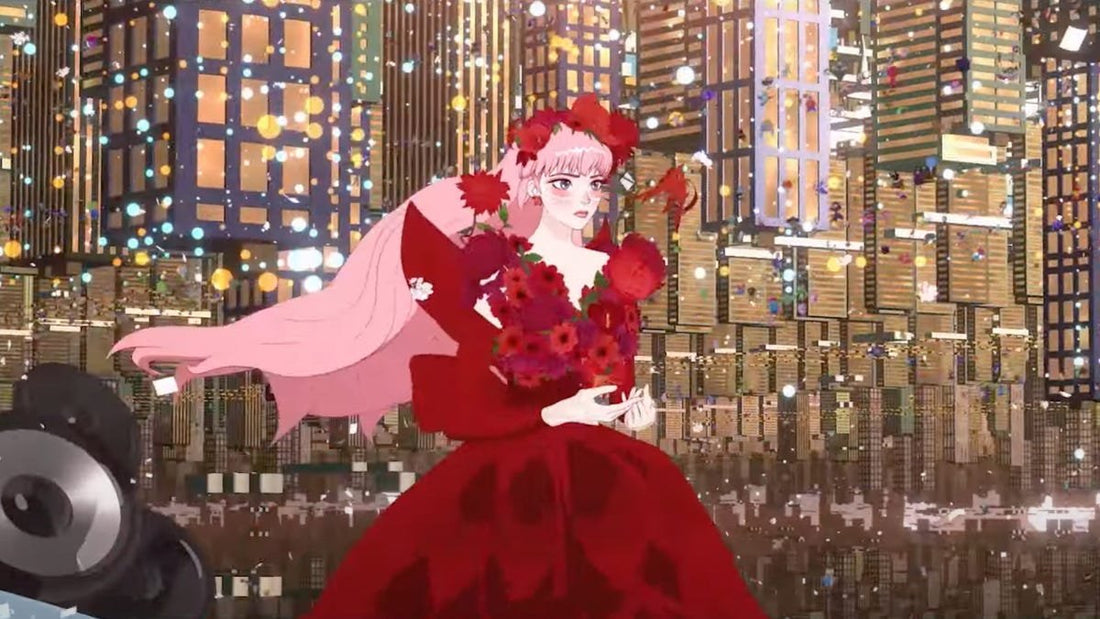Mamoru Hosada’s subversive Beauty and the Beast fairytale unpacks the playful world of opportunity offered up by the internet – particularly vital when it comes to gender identity and the queer potential of cyber spaces. Sam Moore explores how anonymity can be revelatory for queer people in Belle.
The internet has always offered something of a playground to explore gender identity in both life and art. From the trans narratives in the Wachowski’s Matrix franchise, to the constant tension in catfishing and playing across genders in reality TV shows like The Circle, digital spaces are constantly alive with the possibility of queer self-expression, and escapism. While there can be a dark side to the anonymity of cyberspace, there’s also something liberating; without everyone knowing exactly who you are, you’re given the space to find yourself. And while Mamoru Hosoda’s film Belle – a maximalist, musical, pseudo-retelling of Beauty and the Beast – might not be an explicitly queer film, the way it approaches cyberspace, and the not-quite-love-story at the heart of the film, create a contemporary digital world that captures the ways our relationship to pop culture, to celebrity, and to ourselves, have all changed in a way that feels recognisably queer.
At the centre of the film’s futuristic iteration of cyberspace is a smartphone app titled U. U offers users the chance to create “a new you.” The technology draws on both the outward appearance of its users, but also – and more importantly – on what it defines as their “inner strength;” talents, important traits, things that drive them emotionally. For Suzu (Kaho Nakamura), this inner trait is her voice: a singer who has been musically silent since her mother died, she finds the world of U – and the persona that she crafts for herself there, as the eponymous Belle – a welcome escape from the mundanity, loneliness, and grief of her real world. By logging into U, she’s able her own ideal version of herself; a kind of v-tuber/pop star digital celebrity. U offers more than just escapism to Suzu, but that promise of a “new you,” a version of her that might not be feasible outside of cyberspace. Suzu isn’t queer (one subplots is a romantic drama, a love triangle between Suzu, her best friend from childhood, and the archetypal popular girl from school) but her relationship with herself, and the way in which digital performance acts as a mirror for queer narratives, remains striking.
Belle doesn’t look much like Suzu; her freckles are one of her defining features, and they come from Suzu in what the film calls the Origin of Belle (an Origin is the real-life person behind the digital avatar that exists in U). This gulf between the online persona and the person behind it captures not only one of the major tensions when moving through cyberspace but also, in a refreshing way, shows how the digital world of Belle is queer in a way that feels contemporary and real.
One of the key plot points sees characters both in and out of U trying to unmask the Dragon (the film’s Beast to Belle’s Beauty), and during these sequences, as characters try to reach out to people in the real world who might be the Dragon online, both male and female people are considered prime suspects. It’s striking that the possibility of a woman performing as a male avatar isn’t treated as a dishonest bait and switch. Instead, by addressing this in a way that feels almost unimportant, Belle creates a world – both physical and digital – wherein crossing the binary lines of gender is normal. If Suzu is able to (re)create herself using the voice she’s afraid she lost, it makes perfect sense for someone else to use the world of U as a way to create an image of themselves more in line with how they want to be perceived. The offhand portrayal of cross-gender identification in Belle adds to this; it avoids traditional storytelling in the realm of online dramas by omitting tropes around catfishing and deceit, instead showing how earnest and open digital spaces can be. The film’s vibrant visual design adds to this, featuring a vast variety of avatars transcending lines of gender, body types, even offering users more anthropomorphised personalities.
There’s a political streak in Belle reinforcing the potentially queer space U offers; as users try desperately to find and essentially out the Dragon, a group of law and order-obsessed users enter the fray, desperate to use their own standing in U to publicly reveal the Origin of Dragon. This reveals complex dimensions of (un)fixed identity, and the idea that anyone presenting themselves online beyond the way they’re physically perceived is acting in a deceitful way. Looking at Belle through a queer lens, the idea of a forced outing reverberates beyond the Dragon. Dragon isn’t revealed through U, instead tracked down by Suzu and her friends in order to help him escape from a dangerous living situation.
The most striking thing about Belle is the extent to which the film is willing to subvert its source material. In one superb duet, in a flash of vibrant colour, the costumes associated with Disney’s animated film appear on Belle and Dragon, but beyond that, the film exists in another world entirely; the story is more platonic, more open , using a virtual world to explore the ways in which the relationship between how we feel and how we’re seen have changed over time. U offers its users the chance to “change the world,” and in a way, Belle does just that. It changes the digital world, its own underlying queerness a sign of how both our understanding of queer identity, and cyberspace, have changed as time has gone on.
"

